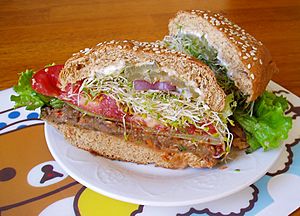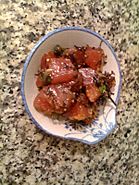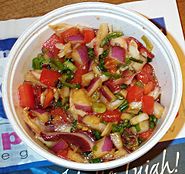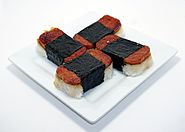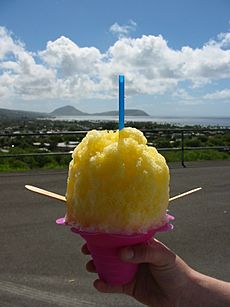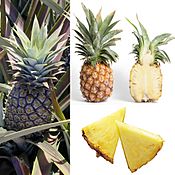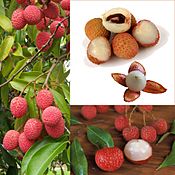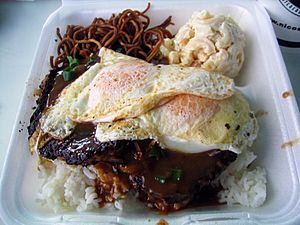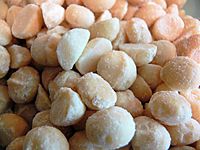List of Hawaiian dishes facts for kids
This is a list of dishes in Hawaiian cuisine, which includes Native Hawaiian cuisine and the broader fusion Cuisine of Hawaii. The Cuisine of Hawaii refers to the indigenous, ethnic, and local cuisines within the diverse state of Hawaii.
Contents
Meals
Breakfast
- Portuguese sausage and/or SPAM, eggs and rice is a common breakfast, so much so that it is featured item at places like fast food restaurants like McDonald's and Burger King.
Entrees and combos
- Plate lunch
- Mixed plate (plate lunch with two types of protein)
- Okazuya
- Loco moco
- Poke
- Musubi, popularly SPAM, and Göteborg musubi on the island of Kauai
Desserts
- Cakes: chantilly, Dobash, guava/rainbow chiffon once a perennial favorite at birthday parties for over 40 years years, haupia
- Dole Whip—though not invented in the islands, Dole and pineapples are associated with Hawaii
- Guri-guri—a sherbet originating from Maui via Japan
- Haupia—a standalone dessert, or coconut flavoring accompaniment to others
- Hawaiian shave ice also known as "ice shave" in other parts of the state
- Kōʻelepālau — Pudding of mashed sweet potato mixed with coconut milk
- Kūlolo—a distant Austronesian relative of the dodol using taro and coconut milk
- Piele — Kūlolo-like dessert made with sweet potato or breadfruit
- Lilikoi bar — local variation of the lemon bar
- Mochi, including butter mochi—a favorite omiyage
- Pies: custard, pumpkin, pumpkin-custard, haupia, chocolate haupia, okinawan sweet potato haupia
- Pumpkin crunch — A variation on the "pumpkin (pie) dump cake" popularized by Sam Choy, often served chilled as a dessert bar.
Breads and pastries
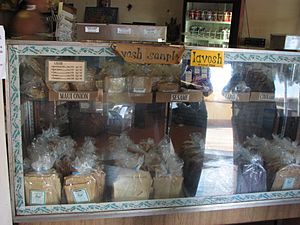
Lavosh sold at the Kanemitsu Bakery counter in Molokai, Hawaii. Flavors offered include Maui onion, sesame, taro and cinnamon.
- Andagi—popular at pop up shops during festivals like Obon
- Anpan
- Apple turnover—made popular by Zippy's as "Apple Napples"
- Banana bread
- Blondies—made popular by Kamehameha Schools called "haole brownies"
- Bok tong go—generically known as "(Chinese steamed) rice cake," a classic item sold by the manapua man; a multiple layered version similar to kue lapis with a brown sugar top layer also exist
- Chinese almond biscuit—simple known as "almond cookie
- Chinese shortbread—or "kong sui ban" a very tender Chinese biscuit whose texture is between a cookie and a cake, often paired with hot tea
- Chinese style bakery buns such as hot dog and ham & cheese
- Chocolate chip cookies and shortbread made with the addition of macadamia nuts
- Coco puffs—a popular cream puff made by Liliha Bakery typically filled with a chocolate pudding and topped with chantilly frosting
- Jindui—a staple during Chinese New Year but eaten throughout the year
- Lavash (or "lavosh") glamourized in the 1960s as a high end alternative to toast
- Malasada—a traditional staple on Mardi Gras but popular throughout the year. Modern recipes have it coated with cinnamon sugar and/or filled with various jams and creams like guava, haupia, or custard
- Manapua—A local iteration of the char siu bao often 2-3 times larger than those found in dim sum restaurants. Popular fillings also include a whole lup cheong sausage, sweet potato, kalua pig, and sometimes is baked made popular by the Royal Kitchen in Chinatown in the 1970s
- Manju—a favorite omiyage for travelers leaving Maui
- Molokai "hot bread"—a well-known export of Molokai that Anthony Bourdain featured it and was even a semifinalist for the renowned James Beard Foundation Award for Outstanding Baker
- Moon cakes—another favorite during the Chinese Mid-Autumn Festival where local flavors are sometimes incorporated like mango and taro.
- Nian gao—(simply known as "gau") a staple of Chinese New Year sold at many Chinese and non-Chinese shops or made in bulk by local households to share with other families
- Poi donuts/ malasadas, mochi
- Portuguese sweet bread or "Hawaiian sweet rolls" outside of Hawaii
- Spanish rolls—a favorite staple to share in the office to go with coffee
- Snow puffies - A variation of the Napoleon pastry
Dairy
- Goat cheese
- Meadow Gold Dairies (Hawaii)
Drinks & Beverages
- ‘Awa
- Blue Hawaii
- Coffee - Kona coffee being the most well-known, but is also cultivated throughout the islands
- Guava nectar
- Hawaiian Punch
- Liliko'i nectar
- Mai Tai
- Māmaki herbal tea
- ʻŌkolehao or oke
- Passion fruit-Orange-Guava (POG)
- Pineapple juice
- Tea - Introduced in the late 1800s. Farmers re-explored the idea of commercial tea farming in the 1980s. Hawaii’s local USDA office, along with University of Hawaii’s College of Tropical Agriculture, aided in research and helped to establish cultivars. Today there are approximately two dozen tea farms in Hawaii.
- Tiki bar
- ʻUala ʻawaʻawa - made from poi of ʻuala that was left to ferment into alcohol
Fruit and vegetables
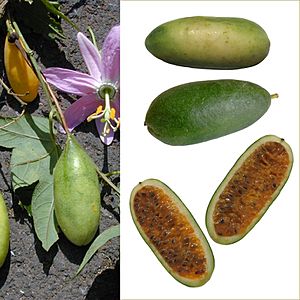
Curuba from Hawaii
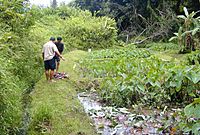
A kalo lo'i harvest in Maunawili Valley. A lo'i is an irrigated, wetland terrace, or paddy, used to grow kalo (taro) or rice. Ancient Hawaiians developed a sophisticated farming system for kalo, along with over 300 variations of the plant adapted to different growing conditions.
- Avocado
- Banana
- Bittermelon
- Breadfruit
- Carambola or "star fruit"
- Cassava
- Chico
- Chili peppers
- Coconut
- Corn
- Curuba
- Custard apple
- Daikon
- Dragon fruit
- Fig
- Fiddlehead fern
- Grape
- Guava
- Herbs
- Lemon
- Lettuce
- Lime
- Longan
- Lychee
- Mango
- Mangosteen
- Marungay
- Mountain apple not to be confused with rose apple
- 'Ōhelo berries
- Maui onion
- Orange
- Papaya
- Passion fruit known as liliko'i (or lilikoi)
- Persimmon
- Poha
- Pineapple
- Pomelo known widely as jabong
- Rice - Although no longer widely cultivated, it was an important crop in the mid-1800s, it's importance sometimes replaced taro paddies
- Soursop
- Squash and melons, including watermelon
- Strawberry
- Surinam Cherry
- Sweet potato or ʻuala from cultivars introduced via ancient Polynesian voyages; and contemporary introductions like Okinawan
- Tamarind
- Taro
- Watercress
- Winged bean
-
Lychee, introduced to Hawaii about 100 years ago
Vegetable proteins and dishes
- Banchan or tsukemono, side dishes including pickles
- Bean paste (confectionary) such as Japanese anko for manjū, or Chinese "black sugar" for jindui
- Champuru
- Chop suey
- Congee - Chinese jook, Filipino arroz caldo, Korean juk, Vietnamese chao
- Jai popular during Chinese New Year
- Miso
- Palusami
- Palula - Leaves of the sweet potato could be used as or along with taro leaves
- Pickles including unripe mangoes, sweet onions, edible seaweed (limu or ogo), radishes for đồ chua and takuwan or danmuji, namasu and various kimchi
- Pinakbet
- Sari-sari - Filipino-inspired vegetable soup
- Tofu
- Watercress soup - common at traditional Hawaiian food restaurants
- ʻUala hoʻomalamala - Prepared like poi but with sweet potatoes
Seasonings & Condiments
- Fermented bean products such as douchi, doubanjiang, gochujang, and miso
- Fina'denne'
- Fish sauce - including patis or nam pla
- Fish paste - such as bagoong monamon
- Shrimp paste - such as bagoong alamang or haam ha
- Furikake
- "Hawaiian" chili pepper and "chili pepper water"
- Chili paste similar to sambal or sriracha
- Chili powder like shichimi or gochugaru
- Chili oil including chili crisp and layu
- Curry (Japanese) powder or roux blocks
- Ginger scallion sauce - called geung yeung, traditionally served with cold ginger chicken, but now also being used as a dressing for fish in poke
- Honey from macadamia and ohia lehua blossoms
- Hoisin
- ʻInamona
- Kalbi marinade
- Kiawe (mesquite) charcoal
- Mayonnaise
- Mirin
- Mandoo dipping sauce for mandoo and meat jun
- Chinese hot mustard sometimes made with Colman's powdered mustard hydrated with vinegar (or water) and often mixed with soy sauce and/or chili paste for dipping Chinese dim sum dishes, or sashimi (as an alternative to soy sauce and wasabi)
- Oyster sauce
- Salt or paʻakai, most famously alaea salt
- Sweet onions, raw
- Liliko'i butter - Fruit curd made with passion fruit
- Ponzu
- Sesame oil
- Soy sauce, categorically known as shoyu
- Tabasco sauce
- Taegu - A combination of gochujang, gochugaru, soy sauce and sesame oil
- Tonkatsu sauce
- Tsuyu dipping sauce, for noodles hot or cold
- Wasabi or imitations made with horseradish
- Umeboshi
- Vinegar - Popular styles include apple cider vinegar and rice vinegar
Meats
Beef
- Chili frank, chili with whole hot dogs (served with rice)
- Beef stew
- Bulgogi
- Canned corned beef
- Corned beef hash - normally shaped into patties
- Hamburger curry stew
- Hot dogs are simply boiled, pan fried, grilled or simmered in a sweetened soy sauce "shoyu dogs" and served with rice
- Kalbi shortribs
- Loco Moco
- Meat jun - a jeon typically made with thin slices of beef sometimes marinated before dipping in egg/egg batter before pan frying
- Pho
- Pipikaula ("beef rope"), a salted and dried beef that resembles beef jerky
- Sukiyaki
- Teriyaki beef
- Teriyaki burgers - a common item at local burger joints, the McTeri is a favorite and seasonal item found at McDonald's
- Teriyaki meatballs
Chicken
- Siu mei dishes: cold ginger chicken, roast duck
- Fried: Chicken katsu, karaage, Korean fried chicken, garlic chicken, "mochiko" chicken
- Grilled: Huli-huli chicken, teriyaki, Korean barbeque
- Stews: chicken adobo, chicken luau stew, Chinese soy sauce chicken, Japanese shoyu chicken, chicken papaya, chicken long rice, nishime
Fish
- Abalone
- Bacalhau
- Butterfish (black cod)
- Kamaboko
- Lomi oio
- Lomi-lomi salmon
- Poke
- Sakura-boshi—yellow-fin tuna jerky
- Sashimi
- Shrimp tempura
- Squid lu'au
Pork
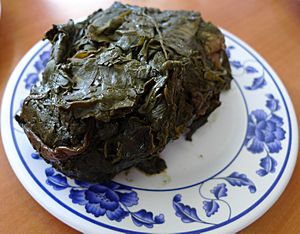
Laulau, a traditional Hawaiian dish
- Adobo
- Cantonese dim sum influenced dishes such as char siu manapua, fun guo is known as "pepeiao" (meaning "ear" in Hawaiian), gok jai or "half moon", pork hash are a normally twice as large than the usual shumai, and "ma tai su" a baked pork and water chestnut pastry
- Crispy gau gee - (kau gee) deep fried dumplings but simply shaped by folding wrapper in half into rectangles or triangles
- Kalua pig
- Laulau
- Lechon
- Portuguese sausage
- Lumpia
- Lūʻau stew
- Musubi
- Pasteles
- Pastele stew
- Pork guisantes
- Rafute
- Siu mei, Cantonese roasted pork including, char siu, siu yuk
- Won ton
- Vinha d'alhos
Noodles/Pasta
- Cake noodles - a serving of chow mein noodles are fried until the outside is crispy, while the inside remains al dente and then cut into squares. It is usually topped with gravied/saucy dishes like beef and broccoli
- Chicken long rice
- Chow fun
- Chow mein
- Look fun
- Pancit
- Saimin, fried saimin
- Yakisoba
Rice
- Bibimbap
- Steamed rice
- Fried rice
- Mochi rice
- Musubi
- Futomaki - simply known as "maki" classic fillings include strips of cucumber, par cooked carrots, tamagoyaki, kampyo, and colored powdered dried shrimp "hana ebi"
- Inarizushi - simply known as "inari" or by its larger local variation "cone sushi"
Snacks and candies
- Arare (or interchangbly as "kakimochi") and senbei
- Coconut balls
- Crack seed such as dried or preserved (wet) lemons, plums, and mangoes
- Dried squid or cuttlefish
- Haw flakes
- "Hurricane" popcorn - popcorn tossed with arare and/or furikake
- Li hing mui (powdered) covered gummy candies and dried fruits
- Macadamia nuts and chocolate covered macadamia nuts
- Maui-style potato chips
- Sesame seed candy
- Shortbread
- Shrimp chip
- Taegu - sometimes made with dried codfish and sold alongside poke in the seafood sections of local grocery store, but often made with dried squid/cuttlefish in households
- One-Ton chips (fried wonton strips)
Soups
- Oxtail soup
- Saimin
- Portuguese bean soup (sopa de feijao)
- Ashitibichi—Okinawan pig's feet soup
- Wonton mein
Specialty products
Starch dishes

A Hawaiian poi dealer, circa 1870
- Macaroni salad
- Poi
- Potato mac salad
- Polynesian arrowroot
See also

All content from Kiddle encyclopedia articles (including the article images and facts) can be freely used under Attribution-ShareAlike license, unless stated otherwise. Cite this article:
List of Hawaiian dishes Facts for Kids. Kiddle Encyclopedia.

